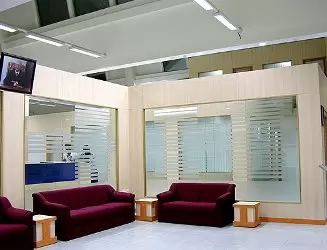Pushing up the green quotient of homes is the modern day fad among the eco-conscious

22-June-2012
Vol 3 | Issue 25
Green is in. With celebrities like Gul Panag showing the way by creating a completely eco-friendly holiday home near Pune, people are increasingly opting for environment-friendly interiors to push up the green quotient of their homes.
"Today it's hip to go organic. With global warming becoming a harsh reality and natural resources depleting, the world is bending towards eco-friendly and renewable resources," says Sapna Aggarwal, creative director of interior design consultancy Ansa Interiors.
 |
|
Experts feel the trend of turning homes into eco-friendly havens will become big (Photo courtesy: C R Narayana Rao Architects)
|
Like Panag who was all over the news recently for her holiday home which has all necessary fittings like double glazed glass panels to make it totally eco-friendly and is one of the first two in India to await a TERI GRIHA certification, more and more couples are opting to make changes that will make their existing homes more "green".
"One might dream of living in a green home, but we cannot all leave our current addresses and head for the forests with hay bales, mud and a wind turbine! But that doesn't mean that you can't do something to make your current abode a little more planet friendly," says Suresh Mansukhani, country manager of Junckers, one of Europe's largest manufacturers of wooden floors.
Organic materials such as bamboo, grass, palm leaves, rich grained oiled wood and driftwood, wicker, feathers, stones, cotton, organic cotton, jute and organic paints emphasise the quality of modern, eco-friendly interiors.
Among fabrics, linens, leather, wool, cashmere, angora and silk strengthen the organic mix.
In addition to these, organic accessories such as bamboo planters, cotton bedcovers, jute chicks for window covering, hand-made earthen sculptures, sea shells, paper mache, and lamp shades made of paper, jute or cotton durries and cotton floor cushions can also help make one's living space more eco-friendly and aesthetically pleasing to the eye.
"I just love the look of cane furniture, cotton durries on the floor and jute mats on tables, with lamps on the side. It just gives a very warm, cosy, welcoming look and I have done up my house accordingly," Sashwati Baruah, a home maker, said.
Baruah's opinion is echoed in a number of restaurants and eateries too as they sport a similar look as her home.
According to architect and interior designer Sanyukta Bharadwaj, eco-friendly paints are also in big demand.
Organic paints can drastically reduce the amount of toxic inhalants at home. They are toxin-free and made with bases of milk protein, lime, or soy and are pigmented with concentrated clays and minerals to achieve a vast array of rich hues.
"A lot of times, while doing interiors, we require a lot of plywood. The eco-friendly option is particle board, which is made by compressing industrial waste along with adhesives and the likes," says Bharadwaj.
"Even in plywood, you can have options such as bamboo ply," she added.
What's more, doing up your home with eco-friendly interior products is not necessarily an expensive option.
"For example, bamboo flooring is definitely less expensive than marble. So are cotton curtains, sea shells, wicker craft, jute and so on," said Ansa Interiors' Aggarwal.
"Not just that, things like organic mattresses that are made of organic cotton or wool are manufactured to be fire-safe alternatives to chemical-soaked foam mattresses," Aggarwal further said.
To give a few ideas to make one's living or working space more healthy and green, designers suggest organic flooring, with natural wood and stone and organic wool carpeting. "Organic flooring builds the ideal base for an eco-green room," Aggarwal said.
Organic bedding materials make toxin-free and even luxurious bed dressings.
"Organic cotton is easy to find. Bamboo fabric is a luxury material made from the quickly rejuvenating plant. Organic bedding is becoming a popular trend, and sheet sets are available at major retailers," said Akash Dey, an interior designer with a private firm.
With more awareness among the masses and the architect and interior designer community, experts feel that the trend of turning homes into eco-friendly havens will soon become big. - IANS














